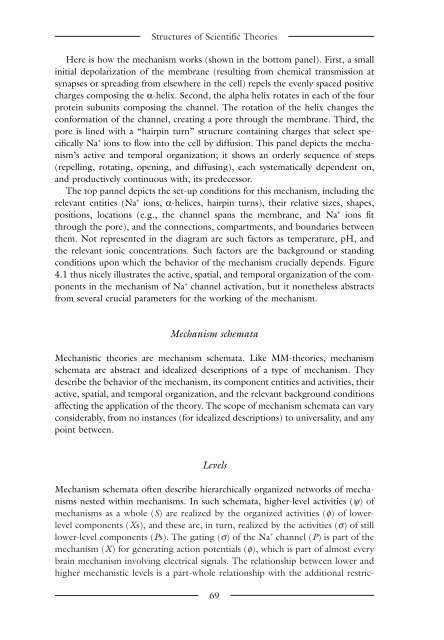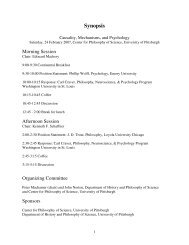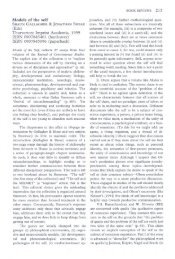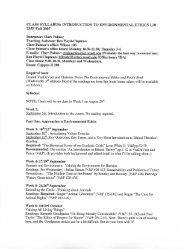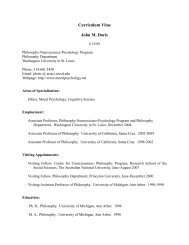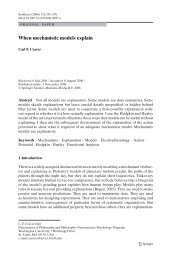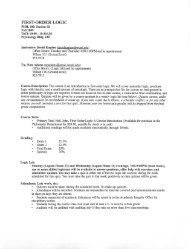The Blackwell Guide to the Philosophy of Science - The Department ...
The Blackwell Guide to the Philosophy of Science - The Department ...
The Blackwell Guide to the Philosophy of Science - The Department ...
You also want an ePaper? Increase the reach of your titles
YUMPU automatically turns print PDFs into web optimized ePapers that Google loves.
Structures <strong>of</strong> Scientific <strong>The</strong>ories<br />
Here is how <strong>the</strong> mechanism works (shown in <strong>the</strong> bot<strong>to</strong>m panel). First, a small<br />
initial depolarization <strong>of</strong> <strong>the</strong> membrane (resulting from chemical transmission at<br />
synapses or spreading from elsewhere in <strong>the</strong> cell) repels <strong>the</strong> evenly spaced positive<br />
charges composing <strong>the</strong> a-helix. Second, <strong>the</strong> alpha helix rotates in each <strong>of</strong> <strong>the</strong> four<br />
protein subunits composing <strong>the</strong> channel. <strong>The</strong> rotation <strong>of</strong> <strong>the</strong> helix changes <strong>the</strong><br />
conformation <strong>of</strong> <strong>the</strong> channel, creating a pore through <strong>the</strong> membrane. Third, <strong>the</strong><br />
pore is lined with a “hairpin turn” structure containing charges that select specifically<br />
Na + ions <strong>to</strong> flow in<strong>to</strong> <strong>the</strong> cell by diffusion. This panel depicts <strong>the</strong> mechanism’s<br />
active and temporal organization; it shows an orderly sequence <strong>of</strong> steps<br />
(repelling, rotating, opening, and diffusing), each systematically dependent on,<br />
and productively continuous with, its predecessor.<br />
<strong>The</strong> <strong>to</strong>p pannel depicts <strong>the</strong> set-up conditions for this mechanism, including <strong>the</strong><br />
relevant entities (Na + ions, a-helices, hairpin turns), <strong>the</strong>ir relative sizes, shapes,<br />
positions, locations (e.g., <strong>the</strong> channel spans <strong>the</strong> membrane, and Na + ions fit<br />
through <strong>the</strong> pore), and <strong>the</strong> connections, compartments, and boundaries between<br />
<strong>the</strong>m. Not represented in <strong>the</strong> diagram are such fac<strong>to</strong>rs as temperature, pH, and<br />
<strong>the</strong> relevant ionic concentrations. Such fac<strong>to</strong>rs are <strong>the</strong> background or standing<br />
conditions upon which <strong>the</strong> behavior <strong>of</strong> <strong>the</strong> mechanism crucially depends. Figure<br />
4.1 thus nicely illustrates <strong>the</strong> active, spatial, and temporal organization <strong>of</strong> <strong>the</strong> components<br />
in <strong>the</strong> mechanism <strong>of</strong> Na + channel activation, but it none<strong>the</strong>less abstracts<br />
from several crucial parameters for <strong>the</strong> working <strong>of</strong> <strong>the</strong> mechanism.<br />
Mechanism schemata<br />
Mechanistic <strong>the</strong>ories are mechanism schemata. Like MM-<strong>the</strong>ories, mechanism<br />
schemata are abstract and idealized descriptions <strong>of</strong> a type <strong>of</strong> mechanism. <strong>The</strong>y<br />
describe <strong>the</strong> behavior <strong>of</strong> <strong>the</strong> mechanism, its component entities and activities, <strong>the</strong>ir<br />
active, spatial, and temporal organization, and <strong>the</strong> relevant background conditions<br />
affecting <strong>the</strong> application <strong>of</strong> <strong>the</strong> <strong>the</strong>ory. <strong>The</strong> scope <strong>of</strong> mechanism schemata can vary<br />
considerably, from no instances (for idealized descriptions) <strong>to</strong> universality, and any<br />
point between.<br />
Levels<br />
Mechanism schemata <strong>of</strong>ten describe hierarchically organized networks <strong>of</strong> mechanisms<br />
nested within mechanisms. In such schemata, higher-level activities (y) <strong>of</strong><br />
mechanisms as a whole (S) are realized by <strong>the</strong> organized activities (f) <strong>of</strong> lowerlevel<br />
components (Xs), and <strong>the</strong>se are, in turn, realized by <strong>the</strong> activities (s) <strong>of</strong> still<br />
lower-level components (Ps). <strong>The</strong> gating (s) <strong>of</strong> <strong>the</strong> Na + channel (P) is part <strong>of</strong> <strong>the</strong><br />
mechanism (X) for generating action potentials (f), which is part <strong>of</strong> almost every<br />
brain mechanism involving electrical signals. <strong>The</strong> relationship between lower and<br />
higher mechanistic levels is a part-whole relationship with <strong>the</strong> additional restric-<br />
69


